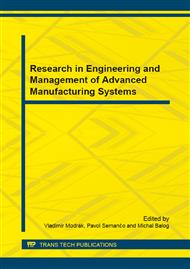p.150
p.156
p.162
p.168
p.173
p.179
p.185
p.192
p.198
Comparison of Reading Speed of Bar Codes and RFID
Abstract:
Quick and easy identification is now at the forefront with producers, transporters, dealers as well as other subjects who need to process large amounts of information in real time as quickly as possible. That is why constantly increasing attention is being paid to automatic identification of objects (AIO). AIO is a fairly broad term that refers to technologies enabling machines to identify real objects. AI is also associated with automatic data acquisition. The technologies should subsequently increase efficiency, reduce errors in recording data and thus free up staff to perform tasks with higher added value. This article focuses on the comparison of the speed of data reading from the "classic bar code" and data recorded by radio frequency identification (RFID).
Info:
Periodical:
Pages:
173-178
Citation:
Online since:
December 2014
Authors:
Keywords:
Price:
Сopyright:
© 2015 Trans Tech Publications Ltd. All Rights Reserved
Share:
Citation:


